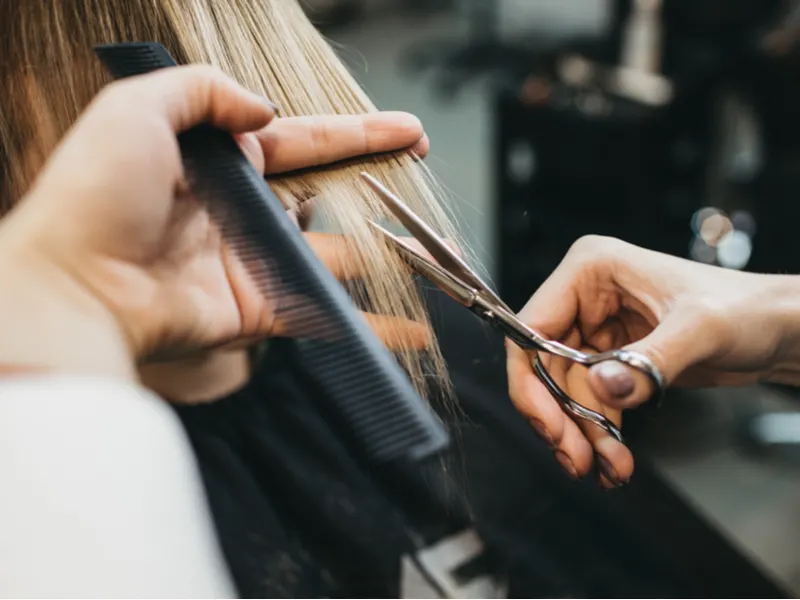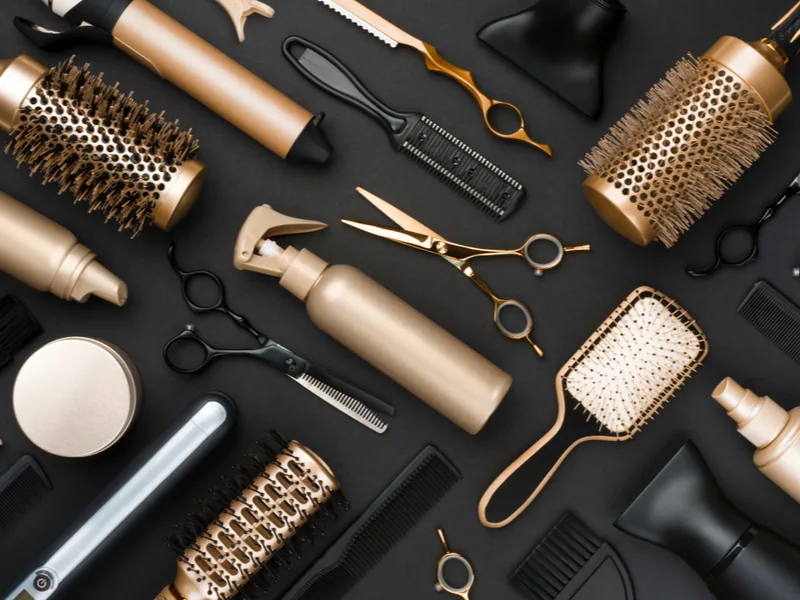Jump to:
If you are looking forward to upgrading your look, then texturizing your hair is good. Learn what texturizing is, the different techniques used for texturizing, and how to care for textured hair.
Texturizing Your Hair: A Summary

t.max/Shutterstock
Texturizing is the process of adding movement and interest to your hairstyle.
It is achieved by using hair texturizers, softening hair ends with a razor, cutting the ends of the hair with the help of thinning shears. Another popular technique of hair texturizing includes point-cutting the hair ends using shears.
In this guide, we’ll cover:
- How do you texturize your hair?
- How to get textured hair: 6 techniques
- Hair texturizing FAQs
Let’s look at the different techniques used to texturize hair.
Read Next: What Is Textured Hair?
How to Get Texturized Hair: 6 Different Techniques
Texturizing your hair helps you get rid of bulk without compromising on the length. It is used not only to create movement but also to break the hair using the wispy effect.
So, if you are looking for more body and bounce to your hair, you should try a texturized hairstyle. Let us look at some of the most popular texturizing techniques.
Texturizing Technique 1: Point Cutting
Point cutting focuses on removing bulk and creating continuous layering for your hair. This transforms an ordinary cut into something that is full of movement. It is used for both men’s and women’s styling, and creates good movement.
Suppose you do not like your present haircut, then point cutting can help you with the right style and shape. Depending on the texture, it is used on both wet and dry hair. Hairstylists can also do point cutting for different hair textures.
If you want a subtle look, then your hairstylist will cut directly into the hair, holding the scissors vertically. But if you want a more dramatic look, the scissors are held at a certain angle for the cut, which will add more texture.
Texturizing Technique 2: Internal Cutting
Internal cutting produces shortened and small chunks of hair at a time. The hair is cut lengthwise along the hair shaft. It is the perfect technique if you are looking out for a modern and smooth hairstyle. It can be done using several methods.
Following are the different methods used for internal cutting:
Method 1: Chipping Method
The most popular is the Chipping Method, where the stylist uses the shear-free hand and cuts hair internally. Here are the steps involved:
- Pulling a section of the hair parallel to your scalp
- Pointing the shears into the ends of the hair and making a 45 degrees angle
- Snipping the mid-length of the section
Method 2: Weaving Method
This method provides more control than the chipping method and involves the use of different cutting angles.
- Separating the hair into slices
- Weaving out strands using a tail comb which is similar to foil highlighting
- Cutting the selected hair in a specific place
Texturizing Technique 3: Twist Cutting
If you want to get bangs or an inverted bob, your hairstylist will go for an angled cut called twist-cutting. So, basically, your stylist will pull a section of your hair, twist them, and then cut.
The technique is to twist the hair with one hand and then use the other hand to takeover while keeping the dominant hand free for cutting.
She will then make a straight cut, and this will get her two sections of hair that are even. Many stylists use a different way of texturizing in which they run and blade on the twist to achieve the desired result.
Texturizing Technique 4: Smooth Cutting
Smooth cutting is a technique generally used for straight hair. It refers to the method of thinning hair with a hairdressing razor. These are special razors with a comb guard that do not allow too much hair to be cut at a time.
For smooth cutting, your hairdresser moves a razor on sections of hair from mid-lengths to tips. The razor slides across your hair in a smooth motion, shortening the hair strands.
Texturizing Technique 5: Slithering
The slithering technique is employed when the hair is thicker. People who have thicker and unmanageable hair benefit greatly from this technique as it removes the extra bulk from your hair.
This technique is also used to make the hair look voluminous. The hair is slithered close to the scalp to provide more volume. This results in shorter hair that holds up the remaining hair, thereby making the hair look heavy.
Only seasoned hairstylists carry out slithering as it requires a lot of practice. If too much pressure is applied when cutting, it can chop the hair off.
Texturizing Technique 6: Using a Texturizer
In this technique, your hairstylist applies a chemical substance called a texturizer to your hair. Texturizing is a permanent chemical process for straightening the hair and is very similar to relaxing.
It is aimed at loosening the curls rather than straightening them completely. In the 1990s, texturizing products were marketed toward men who wanted a wavy hairstyle, but these days it is increasingly popular among women.
A texturizer gives a softer and more manageable look to your hair. Texturizers contain an active ingredient such as sodium or guanidine hydroxide.
They are left on the hair for only a short duration, usually not more than 10 minutes. Texturizers help to remove the extra frizz. Some texturizers contain ammonium thioglycolate, which is less alkaline and produces loosely coiled strands.
Unlike what some people believe, texturizing should not be done at home. Depending upon your current hair texture and what you are trying to achieve, it is best if it is carried out by your hairstylist.
If you attempt this at home using a texturizer, you might over straighten your hair. When done by an expert, texturizing hair with the help of a texturizer adds bounce and makes your strands look beautiful.
Tools Used for Hair Texturizing

Didecs/Shutterstock
Hairstylists use various tools to add body and movement to your tresses. These tools are:
- Straight-edge razor help in removing bulk from the hair during texturizing. The stylist holds strands of your hair between her fingers and cuts them either on top or bottom of the section with an angled razor. The amount of pressure applied will control how much hair is removed.
- Hair clippers helps in cutting the bulk of hair over a larger area.
- Thinning shears (also called blending shears) and are used for texturizing thicker hair. These shears come with a guard that allows only some hair to be chopped at a time without cutting the entire segment.
- Chunking shears are similar to thinning shears, but they are designed for chopping more hair. Hairstylists generally use chunking thicker as well as curly hair.
- Finishing shears, as the name suggests, are used after the texturized look has been created. They are used to provide a clean look as they even out the texture. These shears cut the least amount of hair.
- Tail combs are professional combs with fine teeth. It is used for sectioning and lifting the hair when giving a texturized haircut.
Frequently Asked Questions
How does texturizing help your hair?
Getting a texturized haircut adds bounce and movement to your hair. Texturizing is best for people who want to give an effortless look to their hair, even if it’s been a couple of days since they washed it. Also, if you are bored of your hairstyle and want to try a new and voluminous look, then texturizing is the way to go.
Is it possible to change your hair texture with natural products?
Your hair follicles determine your hair texture, so you cannot do much to change the texture naturally. However, you can keep your scalp hydrated if you want to soften your hair texture.
Go for organic shampoos that keep your scalp moisturized. Also, dry your hair naturally rather than using a blow dryer.
How do you maintain texturized hair?
Here are a few tips that will help you maintain texturized hair:
- Cleanse your hair three to four times a week
- Avoid shampooing more than three times a week as the hair will become dry
- Always wash your hair with warm water
- Use a deep conditioner on your hair at least two to three times a week. A deep conditioner provides an intense hair treatment, and it is formulated with vital conditioning agents. A deep conditioner helps in restoring the moisture level of your hair and in reducing hair breakage.
Does texturizing hair make it thinner?
Texturizing hair does not make it thinner. It is because texturizing scissors are different from thinning scissors. Texturizing scissors have wider teeth and have spaces between each tooth.
Because of the extra space, they remove thicker strands of hair as compared to scissors used for thinning. So, texturizing scissors add bounce and volume.
Does texturizing hair make it frizzy?
Using chemical texturizer results in smooth hair that does not have a frizz. Texturizing is great for your hair. But if it is not done properly, then it can make the hair look too thin and frizzy. That’s why it is always recommended to get your hair texturized by a seasoned hairstylist.
What does texturizing hair spray do?
Hair texturizing spray gives an enduring hold to your hair. So, if you want to retain a particular hairstyle all day long, then using a texturizing spray will hold it in place. Dry textures sprays are also very popular these days. If you want to make your curls last long, then you should go for a dry texturizer.
How often should you texturize your hair with a texturizer?
Texturizers change your hair permanently. If you no longer want texturized hair, then you will have no option but to chop them off and wait for more hair to grow back in. However, if you like the look and feel of your treated hair, then you can texturize every eight to ten weeks.
We suggest you get it done at the hair salon with a professional stylist to get the best results. Hair texturizing is perfect for those who want to add volume or movement to the hair.
It not only imparts a beautiful shine to your hair but also makes your curls more manageable. Moreover, it makes it easier to detangle your hair and so combing becomes a breeze.
The texturizing technique will depend on the type of hair you have. For instance, if you have thin hair, twist cutting, and smooth cutting are good options. For people with thick hair, chipping and slithering can work wonders.
Should You Texturize Your Hair?
By now you know the different tools and techniques for hair texturizing. So, once you have made up your mind regarding texturizing, get in touch with an experienced hairstylist and share your requirements with them.
Your stylist will give you recommendations based on your expectations and your hair type. Once you are convinced with the suggestions, gear up for a beautiful makeover!
